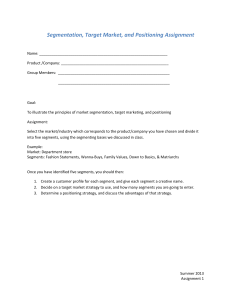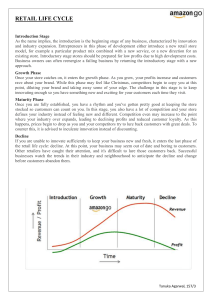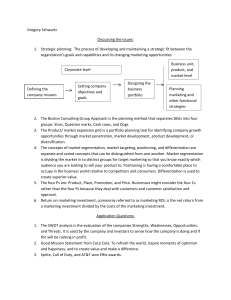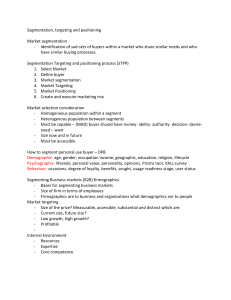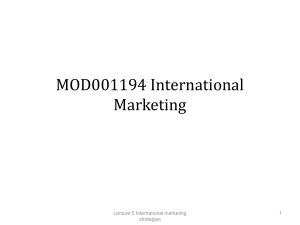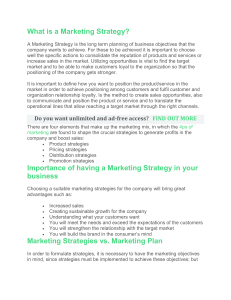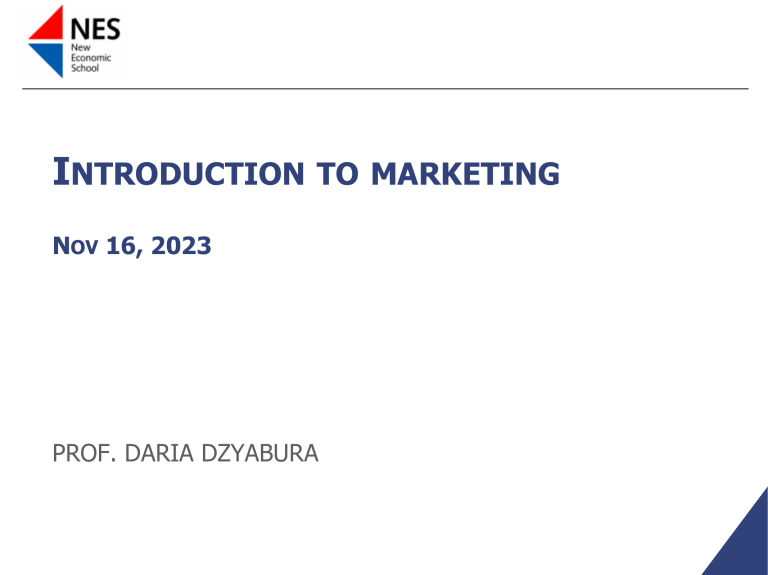
INTRODUCTION TO MARKETING NOV 16, 2023 PROF. DARIA DZYABURA 1 Plan for today • Data fusion & New product development (from last time) • Marketing Decision Framework • Segmentation, Targeting and Positioning • Case Analysis Guidelines • Calyx Flowers Regression results Attribute Color Size Price Strap pad Water bottle Interior Intercept Level Online Partworth Offline Partworth How would you test for significance? Difference Reflective Colorful Blue Black Large Small -0.31** -1.06** -0.22** -0.60** -0.71** -0.11 -0.28* 0.36** -0.12 0.27** -0.31** -0.58** $120 – $180 -0.22** Yes No Yes No Divider for files Laptop sleeve No dividers 0.51** -0.15** 0.25** 0.06** -0.26** 0.45** 0.17** -0.28** 0.52** 0.11 0.88** 0.26** 3.39** -0.33 0.41** 0.62** 3.72** Questions • Which partworths should firms rely on to design products? • Which partworths are the “true” utility (consumption utility)? • What is causing the change? • If offline is correct, how do we collect data in a cost efficient way? • Marginal cost per participant: ~$1 online, ~$30-$50 offline Data Fusion • Measuring what we want is costly • But we can get cheap measurements of something that is correlated with what we want • In this case, collect a small sample of people who complete BOTH online and offline tasks Training Sample Online Prediction sample Data used for estimation Offline Dzyabura, Jagabathula, Muller, 2019, Marketing Science Data Fusion • Measuring what we want is costly • But we can get cheap measurements of something that is correlated with what we want • In this case, collect a small sample of people who complete BOTH online and offline tasks • Two ways to merge the data: • Machine learning (k-nearest neighbors) • Classical statistics (mixed effects model) Dzyabura, Jagabathula, Muller, 2019, Marketing Science k-Nearest Neighbors • For an online respondent, find the closest offline respondents in the sample who completed both (distance measured on online partworths) • Estimate his offline partworths as a weighted average of their offline partworths Random coefficients models • Idea: we need to jointly estimate a model with these two data sets, that allows for correlation between parameters • Used when need individual-level estimates, but not enough data for each consumer • Model population level parameters: normal distribution • Estimate beta, mu, Sigma with maximum likelihood • Hierarchical Bayesian methods for choice models Data fusion for online/offline preferences using random coefficient models • Assume that online and offline partworths are drawn from a joint multivariate normal distribution • The correlation matrices capture relationship between online and offline preferences Which do you think works better? • k-NN predicts individual choices better, but… • Mixed effects model predicts market shares better • What kind of metrics do you want to see? Plan for today • Data fusion & New product development (from last time) • Marketing Decision Framework • Segmentation, Targeting and Positioning • Case Analysis Guidelines • Calyx Flowers WHAT IS A PRODUCT? Product: Anything that can be offered to a market for attention, acquisition, or consumption that satisfies a need. Can be a physical object, service, person, place, organization, idea, or a combination 12 LEVELS OF A PRODUCT Installation Augmented product Packagin g Actual product Brand name Features Core benefit or service Delivery and credit Quality level Core product Aftersale service Design Warranty 13 WHAT IS THE CUSTOMER REALLY BUYING? • Core Customer Value: This is the need that they are having met / the benefit they seek e.g. children’s fever reducing medication • Actual Product: Tangible Attributes & Features Brand name, packaging, design, flavor • Augmented Product: Enhancements Services, customer support, warranty, training, etc. 14 WHY INTRODUCE NEW PRODUCTS • Offensive • Achieve market share or profit goals • New products usually have higher price premium • Products under 5 years old contribute 28% revenue • Develop “resources”: • Complement with existing products → customer loyalty 15 WHY INTRODUCE NEW PRODUCTS • Defensive • Replace declining products 16 STAGES OF THE PRODUCT LIFECYCLE The Effect of Innovations Sales Typical Path Time 17 INNOVATION IS RISKY • Much of new products introduced to market fail • Only 1 in 7 new product ideas commercialized • Increasing order of risk • Repositioning • Product improvement • Additions to product line • New category entries • New to the world products • BUT without innovation, new firms never live and existing firms die 18 CUSTOMER NEEDS VS PRODUCT ATTRIBUTES • Customer does not need an 8mm drill – he needs an 8mm hole! • If I had asked people what they wanted, they would have said a faster horse • • To the customer: a bundle of benefits To the firm: a bundle of attributes 19 Plan for today • Data fusion (from last time) • Marketing Decision Framework • Segmentation, Targeting and Positioning • Case Analysis Guidelines • Calyx Flowers Promotion vs. 22 Product /Packaging 23 Place vs. 24 Price vs. 25 OVERARCHING FRAMEWORK Product Price Promotion Place Distributio n TACTICS 26 “Marketing Mix” – 4Ps • Product • Price • Promotion • Place • Come together to execute a positioning 27 POSITIONING ▪ How should our product be perceived and remembered by customers? ▪ Image in the customer’s mind ▪ NOT a list of all product features 28 EXAMPLES OF POSITIONING 29 Positioning of Bob Chocolate? 30 Examples of Positioning “Breakfast of Champions” “If it's got to be clean, it's got to be Tide” 31 “It’s everywhere you want to be” Marketing Strategy • Who are our target customers? • What is our value proposition to them? 32 STRATEGY VS. TACTICS ▪ ▪ ▪ Strategy: overarching plan to achieve an objective Tactics: actions taken to support the strategy Strategy and Tactics are complementary: ▪ Strategies give tactics a purpose and direction ▪ Tactics convert strategies into actions and results “Vision without action is a daydream. Action without vision is a nightmare” Japanese proverb 33 Defining Marketing Strategy Customers differ on… • Their love for chocolate • Their love for coffee • Income levels • Lifestyles • Shopping behaviors •… Who should we target? Develop positioning for the target market 34 OVERARCHING FRAMEWORK Segmentation Product Targeting Price Promotion Positioning Place Distributio n STRATEGY TACTICS 35 STRATEGY (TODAY) ▪ Segmentation What customer groups are there within the market? Identifying groups with similar needs ▪ Targeting What market segment is the best match for us? Which groups are we better off ignoring? ▪ Positioning How will you communicate your value proposition? A clear simple statement of the benefits of your offering 36 DEVELOPING A STRATEGY ▪ Understanding potential customers ▪ Knowing what you can and cannot do ▪ Knowing your competitors Your Value Proposition 37 OVERARCHING FRAMEWORK Customer Company ANALYSIS Competition Segmentation Product Targeting Price Promotion Positioning Place Distributio n STRATEGY TACTICS 38 WHO ARE THE COMPETITORS OF… Ultrasound turns clothes "ultraclean” SANYO Introduces the World’s First Zero-Detergent Electrolyzed Water Cleaning Powered Washing Machine 39 DEFINITION(S) • Competitor: Any company that seeks to satisfy the same needs that you do or • Any company that requires the same things from customers that you do (uses up the same resources) 40 LEVELS OF COMPETITION • Form (Similar Product) • Category (Concrete Need) • General (Abstract Need) • Resource: Budget, Time, etc. 41 IMPLICATIONS FOR STRATEGY Level of Competition Product management task Product form Convince customers our brand is better than others Product category Convince customers that the product form is the best in the category Generic Convince customers that the product category is the best way to satisfy need Resource Convince customers that the benefit is the best way to spend their resources 42 Case Write-up Guidelines • First case: Calyx Flowers • Group write up due Thursday Nov 22 • I recommend you read the case soon • Case analysis suggestions • Segmentation, Targeting Positioning (this lecture) will be helpful 43 Calyx Flowers Write-up • Executive summary – state your conclusions and recommendations (SHORT!) • Problem/Issue/Situation Analysis using 3C’s • Strategy (STP) • Recommendation and Implementation • Propose best alternative • Provide rationale and implementation plan 44 SITUATIONAL ANALYSIS Customers – Who are they? – How and why do they use the product? – How do they make decisions? – What attributes of the product do they care about? – Do we have a product that meets a need and delivers value? To whom? What is that value? – What are the broad trends in society that affect our customers? 45 SITUATIONAL ANALYSIS Company – What are the strengths and weaknesses? – What are our strategic assets and/or core competencies? – Are we making/losing money? – What is the public perception of our company? 46 SITUATIONAL ANALYSIS Competitors – Who are the competitors? – What are they good/bad at? – What is their “personality”? – What are their goals? – How does their product do relative to ours? – How are competitors likely to react to our moves? – What future competitors may emerge? 47 TACTICS COME TOGETHER TO CREATE VALUE PROPOSITION TO TARGET CUSTOMERS Product Promotion Variety Quality Design Features Packaging Services Advertising Website Social media presence Personal selling Public relations ▪ Target Audience ▪ Intended value proposition Price Retail Price Wholesale price Discounts Pricing scheme Place (Distribution) Channels Locations Inventory 48 Reading cases Read once: • General impressions • Figure out what is the specific problem • Figure out what is the decision to be made Reread with case questions in mind • Do any calculations necessary to answer the problem 49 Calyx Flowers Write-up • 2 pages double spaced • Focus on quality, not quantity! • Writing: the simpler the better. Bullet points is fine. 50 OVERARCHING FRAMEWORK Customer Company ANALYSIS Competition Segmentation Product Targeting Price Promotion Positioning Place Distributio n STRATEGY TACTICS 51 Marketing: Who is it for? Tailoring your marketing to highlight important attributes for each potential consumer Ford’s Model T: “It’s the car for every purse and every purpose” 52 Customer 1 Customer 1 Offering A Customer 1 Customer 2 Offering B Customer 2 Customer 3 Customer 3 Offering C Customer 3 Customer 4 Customer 4 Offering D Customer 4 Customer 5 Offering E Customer 5 Customer 6 Offering F Customer 6 Customer 2 Offering Customer 5 Offering A Offering B Customer 6 Mass marketing Segment-based marketing 53 One-to-one marketing Mass Marketing Ford’s Model T: “It’s the car for every purse and every purpose” 54 One- to-one marketing 55 When is Mass Marketing Appropriate/Effective? • Goods are scarce or a commodity • Goods can sell themselves • Consumers have (virtually) the same needs • Little to no competition 56 Targeted Marketing • An alternative to mass marketing • Involves three key steps: • Segmenting the market (“S”) • Choosing the target segment(s) that are right for you (“T”) • Positioning the product for a chosen target segment (“P”) Benefits of STP To the Firm … To the Customer … • Identification of valuable • Customized products & • Efficiency in marketing • Relevant promotions customer segment(s) services communications • Personalized and efficient • Higher customer lifetime interactions with firm value Increased Profit 58 Higher Satisfaction Segmentation • Definition: grouping consumers by some criteria, such that those within a group will respond similarly to a marketing action and those in a different group will respond differently. • Alternatively, marketing segmentation is a marketing strategy that involves dividing a broad target market into subsets of consumers who have common needs and application for the relevant goods and services. • A study done by Harvard Business claimed that in the US, 85% of 30,000 new product launches failed because of poor market segmentation. 59 Segmentation 60 Segmentation Dove “Real Beauty” campaign 62 Some Potential Segmentation Variables for Shampoo • • • • Demographics: Race/ethnicity, age, income Hair Type: curly/straight, color (blond, brunette, redhead) Problem hair: dandruff, oily, dry, color-treated, lice, thin/limp Involvement: do they care about hair products? Willing to spend a lot on hair products? • • Activities: Runners, Swimmers, Travelers Location: L.A. (sun damage and hard water) versus New York (dry winter and humid summer) • Personality: Eco-friendly, anti animal cruelty, “real beauty” 63 More generally… • Geography – nations, states, regions, cities, urbanrural, other. • Demographics – Age, Gender, family size, life cycle, income, education • Psychographic – Social class, lifestyle, personality • Behavioral – Occasions, benefits, uses, responses 64 Segmentation • Definition: grouping consumers by some criteria, such that those within a group will respond similarly to a marketing action and those in a different group will respond differently. 65 Market Segmentation Strategies Non-segmented market Segmentation I Segmentation II 66 Segmentation III Characteristics of Good Segmentation • Separating prospective buyers into groups such that • within a group: • Similarity is high • Needs are common • Responses to marketing action are similar • between groups: • Similarity is low • Needs are different • Responses to marketing action are different • Segments should be: • Large Enough • Identifiable • Distinctive • Stable 67 STP Simulation Product: Home Pregnancy Tests 68 The Early Pregnancy Test Market “Walk into an Osco drugstore, and on a shelf near the ovulation testing kits you’ll find Conceive brand pregnancy tests. A cherubic infant smiles at you from the pink box ……. A little farther down the aisle, and near the condoms, you’ll find another pregnancy test, called RapidVue. The package features no smiling baby, just brick-red lettering against a mauve background. Both tests are products of San Diego-based Quidel Corp. -- and they are identical except for the packaging.” (Forbes, August 29, 1994, p 78) Segmenting the Early Pregnancy Test Market Brand Name Price Packaging Shelf Position 70 Segmenting the Early Pregnancy Test Market: Desired Outcome Brand Name Price Packaging Shelf Position The hopefuls The fearfuls Conceive RapidVue $9.99 $6.99 Pink box, smiling baby Mauve background, no baby Near ovulationtesting kits Near condoms 71 Segmenting the Early Pregnancy Test Market: Desired Outcome Brand Name Price Packaging Shelf Position The hopefuls The fearfuls Conceive RapidVue $9.99 $6.99 Pink box, smiling baby Mauve background, no baby Near ovulationtesting kits Near condoms 72 Targeting • Definition: identifying which customers to serve and which to ignore 73 Targeting Segment A Segment B Segment C Evaluating Market Segments • Segment Characterstics (“Customer”) • The segment must offer long term revenue potential (consider segment size, growth, buying power, loyalty) • Segment must be cost-efficient to reach • Competitive advantage • What is the level of competition in the segment? • The company must be able to serve the segment better than its competitors • Segment compatibility • The segment must be compatible with the company’s core competency, brand image, and goals 75 An Ideal Segment • • • • • • Large, Growing Stable Accessible Profitable: • High barriers to entry and Low exit barriers, Low regulation, • Low competitive intensity, high Willingness To Pay (WTP) With Unmet Needs Where you have a competitive advantage • Synergistic 76 New York Times Jan 16, 2007 Tactical Targeting Scenarios “Sniper” targeting (perfect fit) “Shotgun” targeting (broad) Oversegmentation (narrow) Likely to buy product(unobservable) Targeted (observable) © 2006 Alexander Chernev Shot-in-the-dark (misaligned) Example of Oversegmentation 79 Multiple Needs 80 Multiple products, multiple segments 82 Multiple products, multiple segments 83 Multiple products, multiple segments 84 Who: Geographic Segmentation 85 One product, multiple segments 86 Zipcar: multiple segments, one product 87 Pepperidge Farm: multiple products, one segment 88 Multiple Products, One Segment 89 Targeting Multiple Segments One Product Multiple Target Segments - Himalayan Salt - Tom’s of Maine - Botox - Zipcar - Starwars - Hybrid Cars Multiple Product One Target Segment - Music - Lego - Ben & Jerry’s - BMW, Mini - Colgate 90 Positioning • View of how our offering should be perceived and remembered by customers • Process of creating a distinct image in the customer’s mind 91 Example: Emergen-C vs. Airborne 92 Positioning Tool: Perceptual Map 94 Positioning strategies More/ Smaller/ Cheaper/ Faster/ Vertical positioning Horizontal positioning Different/ Lifestyle/ 97 Vertical positioning The Razor Battle Gillette ups the ante, unveils 5-blade razor 98 Razors: Horizontal Differentiation • DollarShaveClub 99 Wii 10 Developing a Positioning Strategy: Guiding Questions ❑Which positions are of greatest value to our target customers, given their needs? ❑Which of these positions are “taken,” and which positions are relatively free of competition? ❑Which of the available positions fits best with our objectives and our distinctive capabilities, i.e., can we back up the chosen positioning by demonstrable product attributes or benefits? ❑Can we “change the rules” of the game by discovering new critical points of differentiation? ❑Are all our positioning messages consistent? 10 For next time Calyx writeup Think about project topic
